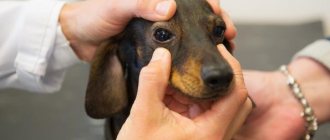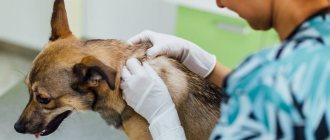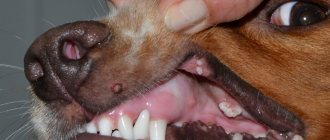Reasons caused by external factors
Normally, every dog has a small amount of dandruff. These white particles are dead skin cells. They peel off, and new epithelium appears in their place.
Typically, skin renewal processes go unnoticed. But with various deviations, the functions of the sebaceous glands are disrupted, and the dog’s body becomes covered with white flakes.
Most of them are in the area of the back, neck, ears, at the base of the tail, less - on the paws, stomach, chest.
Dandruff often occurs under the influence of aggressive external factors, without disrupting the functioning of the body. Such causes are the easiest to identify and eliminate.
Allergy
Allergic reactions can occur to anything: food, cosmetics, medications, clothes your pet wears, even cold or sunlight (ultraviolet radiation). Once the root cause is eliminated, dandruff disappears within a couple of weeks.
Poor nutrition
The condition of the coat and skin is negatively affected by a lack of animal protein, vitamins A, E, C, D, group B, fatty acids and amino acids.
Dandruff often appears in dogs that eat cheap food or the same food that the owner eats. Often such pets have a lot of fur.
The pet's diet must be balanced: the animals are fed either high-quality dry food and canned food, or a full menu of meat, cereals, vegetables, and dairy products.
Prevention
All prevention of dandruff lies in proper care of your pet. The dog should be in comfort and good conditions. A proper balanced diet is especially important. Dry food should be purchased only of high grades. If feeding natural products, you should additionally purchase a vitamin-mineral complex for your dog.
Such measures will prevent your pet not only from dandruff, but also from other diseases, most of which arise from poor care. A dog is a real member of the family for a person and care for it must be appropriate.
What diseases cause dandruff?
The situation is worse when white flakes appear not due to external factors, but due to pathologies - skin or systemic.
In such cases, it is impossible to simply eliminate the root cause and enjoy a clean dog coat in a few days or a couple of weeks.
You will have to undergo a full examination, take numerous tests, and follow a long and tedious course of treatment.
Skin diseases
Typically, dandruff is caused by the following skin diseases:
- fungal infections;
- dermatosis;
- dermatitis – allergic or atopic;
- bacterial infection;
- scabies (sarcoptosis);
- lichen (dermatophytosis).
In case of pathologies, the dog will also show other symptoms:
- excessive hair loss, local alopecia;
- skin hyperemia;
- thickening of the epidermis;
- increased greasiness;
- various injuries - sores, scratches;
- rash.
Only a veterinarian can make an accurate diagnosis.
Often, dandruff in skin diseases is not white, but yellow, red or even black.
Yellow color indicates excessive work of the sebaceous glands; dandruff in this case will be greasy, stick to the fur, and difficult to comb out.
Red and black shades are not dandruff as such, but damaged skin cells. Flakes of a non-standard color appear when combing: the owner simply scratches off the damaged layer of the epidermis with dried blood.
Seborrhea is the most common cause
Most often, abundant flakes occur due to seborrhea. This term is mistakenly considered synonymous with dandruff. It should be understood that white scales are a symptom, and seborrhea is a disease that occurs due to disruption of the sebaceous glands and excessive skin growth.
At first, only severe dry or oily dandruff appears. As it progresses, the hairs become oilier and there is a distinct odor that does not disappear even after bathing. Then the skin turns red, becomes covered with cracks and scratches.
At an advanced stage, an infection occurs. It enters through wounds on the skin. It is very difficult to remove dandruff in this phase of the disease.
Systemic pathologies
The condition of a dog's skin is affected by its overall well-being. If dandruff occurs, and all external factors and possible skin diseases are excluded, you should look for the cause among the pathologies of internal systems and organs.
They are:
- kidney and liver diseases;
- diabetes;
- intestinal infections;
- hormonal and thyroid disorders.
If dandruff appears in a puppy dog, it is necessary to rule out vitamin deficiency and postpartum depression.
In uncastrated male dogs, whitish flakes may appear due to unrealized sexual instinct. A large surge of hormones, coupled with unmet needs, provokes a malfunction of the thyroid gland and adrenal glands. These problems affect the condition of the skin.
Treatment
Since there are many reasons, the course is prescribed individually, depending on the situation. Treating fungus and dealing with stress are markedly different. What can you do? Purely preventive measures .
- Create a bathing schedule if you suspect this may be the cause. Be sure to consult with your veterinarian, as for some diseases it is important to follow the recommendations.
- Increase air humidity. In case of a “drought”, this will be useful in any case. You can, for example, place wet towels on radiators.
- Change your diet. Give preference to foods that contain dehydrated meat of a specific type in the first place: turkey, chicken, lamb, etc.
- Brush your pet more often. It is advisable to use a massage comb to increase blood flow to the skin.
Sometimes owners start bathing their dogs with tar soap , after which the dandruff disappears. This is a dubious success, since the product dries out the skin and relieves itching, but does not cure. If the cause is internal disorders, health will continue to deteriorate. In addition, tar soap will help get rid of oily dandruff, and with dry dandruff it will aggravate the situation.
Peeling skin is a sign of many disorders in the dog’s body. Sometimes scales can be seen normally during molting. However, in case of serious damage, it is better to first visit a veterinary clinic and then draw conclusions. In any case, adhere to prevention, monitor your dog’s diet and care for its coat.
Dandruff treatment in a veterinary clinic
Dog dandruff is not as minor a problem as it may seem. When it appears, you must contact a veterinary hospital - only a doctor can determine the exact cause. He will also give instructions on how to treat the disease and what the animal owner should do.
To identify the provoking factor, the following examinations are prescribed:
- blood tests - general and biochemical;
- scraping from the skin;
- allergy tests;
- mycological and bacteriological research.
Additionally, the owner is asked about the dog’s dietary habits, specific care, and lifestyle.
Which treatment strategy will be chosen depends on the underlying cause:
- if fleas, ticks, or worms are present, antiparasitic treatment is prescribed;
- for bacterial or fungal infections, drugs with the appropriate effect are prescribed;
- in case of allergies, eliminating the allergen and taking antihistamines is indicated;
- with an unbalanced diet, a course of vitamins and normalization of the diet are necessary.
Causes of dandruff in dogs
We will analyze in detail all the causes of dandruff in dogs, depending on the type of disease, because dandruff can be accompanied by other ailments. Typically, the cells in the upper layers of a dog's skin gradually die and are replaced by new ones. As a rule, this is a gradual process, not too noticeable to the eye. If a dog’s dandruff appears in large quantities, then something is wrong with the pet’s body.
Dandruff can appear due to stress. This is one of the easiest cases. When the dog calms down, everything goes away by itself.
Among other things, dandruff on a dog’s back is one of the signs of the presence of parasites on the surface of the animal’s skin. For example, cheyletiellosis, or in simple terms, wandering dandruff, is a parasitic tick-borne disease. The disease is manifested not only by the presence of an abundant amount of scales on the back and other areas of the skin. Animals are also tormented by itching, sometimes leading to areas of alopecia caused by scratching.
Dandruff and hair loss
Naturally, hair falls out twice a year. Every person who has ever kept a dog or cat at home has experienced the fact that the pet sheds. Sometimes this process is so intense that the animal even has to be combed out.
It also happens that hair loss is the cause of some disease and shedding has absolutely nothing to do with it. If this process is accompanied by abundant dandruff rashes, then this is a reason to show your pet to a specialist.
Hair loss and dandruff in dogs can be caused by:
- separation from the owner;
- post-traumatic state;
- stress;
- other circumstances.
It could also be an allergic reaction. Animals are often allergic to various foods, especially low-quality food. Common pet allergens also include dust, pollen and fleas. All of them can cause dandruff and hair loss. Allergens also include substances that a dog can come into contact with. The most common of them are:
- various materials with synthetic components;
- household chemicals (detergents, cleaning products);
- medications;
- shampoos, etc.
Solar dermatitis also leads to loss of skin and the formation of dandruff on various parts of the body. Dogs can go bald even from infection with helminthic infestations, especially those that have recently suffered a serious illness and their body has not yet fully recovered. How to get rid of dog dandruff and hair loss depends on each specific case.
Dandruff and sores
Skin problems in dogs are becoming more common. There are many reasons for the appearance of dandruff and sores:
- Contact with stray dogs.
- Sedentary lifestyle.
- Poor environmental conditions.
- Poor nutrition.
Also, sores and dandruff in dogs often appear due to a hereditary predisposition of the skin to diseases.
The most common skin diseases include:
- Allergies and atopic dermatitis.
- Allergic dermatitis is a skin reaction to secretions from body parasites and their bites.
- Sarcoptic mange (scabies). The reason for the appearance of dandruff and sores lies in parasites that bring discomfort to the dog.
- Ectoparasites are various types of ticks, fleas and lice that parasitize the skin of a pet.
- Lichen or scientifically - dermatophytosis. A dog infected with this disease will develop bald patches on various parts of the body.
Itching and dandruff
There are many reasons that can cause dandruff and itching in a dog, and parasitic diseases should be considered first. Many dog owners underestimate fleas, but the likelihood that these small insects can cause itching sensations, followed by the appearance of dandruff, is extremely high. Parasite bites, in addition to the usual discomfort, can cause allergies in your pet. For particularly sensitive animals, just a couple of bites are enough.
Itching and dandruff can be caused by mites. In order to identify them, the dog must be taken to the veterinarian. A specialist will do a scraping - an effective method for identifying mites. However, there is a special type of mite that causes sarcoptic mange - scabies in animals. This type of mite is difficult to detect even with scraping. But in any case, a qualified person is able to find out the root cause of dandruff and itching in a dog and prescribe appropriate treatment.
It is also worth considering the microflora on your pet’s skin. If the dog’s body condition is in perfect order and the pet does not have skin diseases, then the microflora does not cause problems for the animal. However, against the background of diseases, the number of these organisms grows exponentially, which negatively affects the condition of the skin. If there is a bacterial or fungal disease, the dog should be treated by a specialist. Only a veterinarian can perform tests to confirm or rule out the presence of organisms that are causing the disease.
If all of the above options are excluded, then most likely the pet suffers from allergies.
Large dandruff
A common cause of large dandruff in dogs is a disease called seborrheic dermatitis. This is a fairly common disease, the characteristic symptom of which, in addition to dandruff, is oily skin. Also, your pet often smells unpleasant. Seborrhea is a hereditary disease and can even appear in puppies.
Also, large dandruff in a dog can appear due to the peculiarities of caring for the pet:
- Rare washing. If you wash your dog rarely, and even incorrectly, then a lot of skin cells mixed with subcutaneous fat accumulate on its skin. As a result, the animal develops dandruff in the form of large flakes.
- Dermatitis is an inflammation of the skin without the formation of a rash. This could be allergic dermatitis (improper, poor, excessive nutrition), parasitic dermatitis (dog has fleas, ticks). In some cases, dermatitis can be drug-induced and thermal (frostbite, burns).
When you notice large dandruff in your dog, the main thing is to start treatment on time. Otherwise, the peeling process will become chronic. The skin will become significantly rougher and thicker, and hair may fall out in the affected areas.
In this video, a veterinarian talks about the causes of dandruff in dogs:
How to help a dog yourself?
The main treatment should be carried out as prescribed and under the supervision of a veterinarian. But at home you can reduce the severity of symptoms - remove dandruff and reduce itching.
All independent actions are used only as an additional remedy and in consultation with a doctor.
Shampoos
The easiest way to get rid of dandruff is with special shampoos. They contain salicylic acid, benzoyl peroxide, tar, sulfur, vitamins A and E, and medicinal plant extracts.
The best means are:
- Globalvet "Dandruff";
- 8in1 “Perfect Coat” with tar;
- "DoctorZoo";
- Goodman "Doctor";
- "Cytoderm";
- ESPREE "LUXURY TAR & SULFA" with sulfur.
Additionally, you can treat your pet's skin with Stop Itching spray. It relieves irritation and redness.
Medications for dandruff
If there are no visible causes of dandruff , then treatment is symptomatic. Prescribed medications that relieve skin irritation and reduce the amount of dandruff. Basically this is lotion, conditioner, anti-dandruff shampoo for dogs, sometimes food vitamin supplements. In some cases, more serious drugs are used.
Most often, medicinal cosmetics contain sulfur, tar, salicylic acid or benzoyl peroxide. Such drugs can be found in any pet store or veterinary pharmacy. Popular means are:
Stop itching
Medicine in the form of a spray. Soothes skin irritation and relieves itching. Dogs quickly feel better after using it. Suitable for many skin diseases.
Frontline
Spray against external parasites. With a correctly calculated dose, the animal gets rid of fleas, ticks, lice eaters and other parasites, and along with them, discomfort. The product is used for both therapeutic and preventive purposes.
Stronghold
Antiparasitic drug in the form of drops. It is applied to the withers, and for large dogs along the spine, but only strictly in those places where the animal cannot lick it off or reach it with its paws. Works just like Frontline.
Shampoo "Doctor"
Dermatological cosmetic product that soothes the skin and relieves inflammation. They produce several types of shampoo, differing in composition and aspects of action. Bathing your pet with this product will relieve it from itching and improve the condition of its skin and coat. As a result, dandruff disappears and the unpleasant odor, which is often present with skin problems, is reduced.
If the owner is not sure of the cause of the problem, you should not use such drugs at random. It is better to get qualified advice and follow the advice.
Diagnostic methods
After an initial examination of the dog’s coat and skin, the veterinarian will prescribe a series of laboratory tests to determine the cause of seborrheic dermatitis or other type of dandruff:
- skin scraping;
- CBC (complete blood count);
- blood test for biochemistry;
- examination of stool and urine;
- biopsy.
The doctor does not necessarily prescribe the entire list of tests. After examination and medical history, he can give a referral for 1-3 studies.











